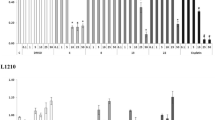Summary
The utility of 4-hydro-peroxy-cyclophosphamide for testing the selectivity of human tumours cells against cyclophosphamide in vitro was studied. 4-hydro-peroxy-cyclophosphamide in aqueous solution spontaneously decomposes to 4-hydroxy-cyclophosphamide, the primary product of metabolic activation of cyclophosphamide thus representing a new form of “activated” cyclophosphamide. From 31 human tumours including 21 mammarian-, 4 ovarial-, 2 uterine-carcinomas, 2 seminomas, 1 hypernephroma and 1 rectum-carcinoma cell suspensions were made and the effect on the 3H-Uridine- and the 3H-Thymidine-incorporation into the nucleic acids after short time incubation with the effect of 4-hydro-peroxycyclophosphamide and 4-hydroxy-cyclophosphamide. 7 malignomas showed high sensitivity both against 4-hydro-peroxy-cyclophosphamide and against 4-hydroxy-cyclophosphamide. No additional inhibitory effect of the peroxyde function besides of that of the alkylating moiety of the molecule was found. Accordingly 4-hydro-peroxy-cyclophosphamide because of its better availibility and stability may be used as “activated” cyclophosphamide in screening tests for cyclophosphamide-sensivity of human tumours in vitro.
Zusammenfassung
Es werden Versuche beschrieben, anstelle von 4-Hydroxy-Cyclophosphamid (dem biologischen Aktivierungsprodukt von Cyclophosphamid in vivo), das synthetisch besser zugängliche und stabilere 4-Hydroperoxy-Cyclophosphamid für die Sensibilitätstestung menschlicher Tumoren gegen Cyclophosphamid einzusetzen. 4-Hydro-peroxy-Cyclophosphamid geht in wässriger Lösung unter physiologischen Temperatur- und pH-Bedingungen spontan in 4-Hydroxy-Cyclophosphamid und dessen Folgeprodukte über und stellt demnach eine weitere Form von „aktiviertem“ Cyclophosphamid dar.
Unsere Untersuchungen an 31 Tumoren (21 Mamma-, 4 Ovarial-, 2 Korpuscarcinome, 2 Seminome, 1 Hypernephrom und 1 Rektumcarcinom) zeigen, daß die Hemmung des 3H-Uridin- und des 3H-Thymidin-Einbaus in die Nukleinsäuren der Tumorzellen nach Kurzzeitinkubation mit 4-Hydro-peroxy-Cyclophosphamid und 4-Hydroxy-Cyclophosphamid praktisch gleich ist. 7 Malignome erwiesen sich in diesem Test als hochempfindlich gegenüber beiden Formen von aktiviertem Cyclophosphamid. Ein zusätzlicher Effekt der Peroxy-Funktion über den der alkylierenden N-Lostgruppe des 4-Hydro-peroxy-Cyclophosphamid hinaus war nicht meßbar. Wegen seiner besseren Verfügbarkeit und Haltbarkeit erscheint deshalb 4-Hydro-peroxy-Cyclophosphamid als aktivierte Form von Cyclophosphamid für die Sensibilitätstestung von Tumoren in vitro geeignet.
Similar content being viewed by others
Literatur
Bastert, G., Hohorst, H.J., Peter, G., Schmidt-Matthiesen, H., Voelcker, G.: In vitro-Sensibilitätstestung von Tumoren gegenüber aktiviertem Cyclophosphamid (4-Hydrox-Cyclophosphamid). Kurzzeitinkubation von Originaltumorzellen und 3H-Uridineinbau. Erste Mitteilung. Z. Krebsforsch 84, 37–47 (1975)
Bastert, G., Schmidt-Matthiesen, H., Gerner, R., Michel, R.T., Nord, D., Leppien, G.: In vitro-Sensibilitätstestung vom Mammakarzinomen gegen Zytostatika. Kurzzeitinkubation von Originaltumorzellen und 3H-Uridineinbaubestimmung. Dtsch. med. Wschr. 100, 2035–2042 (1975)
Brock, N., Hohorst, H.J.: Metabolism of Cyclophosphamide. Cancer 20, 900 (1967)
Brock, N., Hohorst, H.J., Gross, H.J., Klein, H.O., Schneider, B.: Aktivierung von Cyclophosphamid beim Menschen und Tier. Cancer 27, 1512 (1971)
Brock,N.: Vortrag auf der Tagung d. Arbeitsgruppe: Zytostatika in Ziegelhausen. Okt. 1974
Hohorst, H.J., Ziemann, A., Brock, N.: 4-Ketocyclophosphamide, a Metabolite of Cyclophosphamide. Arzneimittel-Forsch. 21, 1254 (1971)
Hohorst,H.J., Draeger,U., Voelcker,G., Brock,N.: Vortrag auf dem XI.Intern. Cancer Congress. Florenz 1974
Kummer,D.: Messungen im Nukleinsäurestoffwechsel solider Tumoren in vitro und deren Bedeutung für die Chemotherapie. Vortrag auf dem Deutschen Krebskongress, München, Febr. 1974
Limburg, H., Krahe, M.: Züchtung von menschlichem Krebsgewebe in der Gewebekultur und seine Sensibilitätstestung gegen neuere Zytostatika. Dtsch. med. Wschr. 89, 1938 (1964)
Peter,G.: Diplomarbeit. Fachbereich Chemie der Univ. Frankfurt/M. 1971
Peter,G.: unveröffentlichte Beobachtung
Rajewski, M.F.: Zellproliferation in normalen und malignen Geweben. 3H-Thymidineinbau in vitro unter Standardbedingungen. Biophysik 3, 65 (1966)
Seidel, H.J., Wegner, L.A.: Zur Sensibilitätsbestimmung von Tumoren in vitro. I. Vergleichende Untersuchungen am Jensen-Sarkom in vivo und bei 1 stündiger Inkubation in vitro. Z. Krebsforsch. 72, 105 (1969)
Seidel, H.J.: Zur Sensibilitätsbestimmung von Tumoren in vitro. II. Testungen am soliden Ehrlich Carcinom der Maus und an einem menschlichen Colon-Carcinom nach Heterotransplantation (GW 77). Z. Krebsforsch. 74, 131 (1970)
Sladek, N.E.: Evidence for an Aldehyde Possessing Alkylating Aktivity as the Primary Metabolite of Cyclophosphamide. Cancer Res. 33, 651 (1973)
Takamizawa, A., Matsumoto, S., Iwata, T., Katagori, K., Tochino, Y., Yamaguchi, K.: Studies an Cyclophosphamide Metabolites and Their Related Compounds. II. J. Amer. chem. Soc. 95, 985 (1973)
Tanneberger, S., Bacigalupo, G.: Einige Erfahrungen mit der individuellen zytostatischen Behandlung maligner Tumoren nach prätherapeutischer Zytostatika-Sensibilitätsprüfung in vitro (Onkobiogramm). Arch. Geschwulstforsch. 35, 44 (1970)
Voelcker, G., Draeger, U., Peter, G., Hohorst, H.J.: Studien zum Spontanzerfall von 4-Hydroxycyclophosphamid und 4-Hydroperoxycyclophosphamid mit Hilfe der Dünnschichtchromatographie. Arneimittel-Forsch. 24, 1172 (1974)
Voelcker,G.: Persönliche Mitteilung
Volm, M., Kaufmann, M., Mattern, J., Wayss, K.: Möglichkeiten und Grenzen der prätherapeutischen Sensibilitätstestung von Tumoren gegen Zytostatika im Kurzzeittest. Schweiz. med. Wschr. 105, 74 (1975)
Volm, M., Kaufmann, M., Wayss, K., Goerttler, K., Mattern, J.: Gezielte Tumor-Chemotherapie durch Onkobiogramm. Dtsch. med. Wschr. 99, 38 (1974)
Volm, M., Bastert, G., Mattern, J., Wayss, K.: Onkobiogramm und Therapieerfolg bei Transplanta-tionstumoren. Naturwissenschaften 60, 395 (1973)
Weitzel, G., Budecke, E., Schneider, F., Pfeil, H.: Einwirkung organischer Per-Sauerstoff-Verbindungen auf das Mäuse-Ascites-Karzinom in-vivo. Hoppe-Seylers Z. physiol. Chem. 325, 65 (1961)
Wüst, G.P.: Sensibilitätstestung maligner Tumoren gegen Zytostatika in vitro und in vivo. Münch. med. Wschr. 115, 839 (1173)
Author information
Authors and Affiliations
Additional information
1. Mitteilung: Bastert et al. 1975a.
Rights and permissions
About this article
Cite this article
Bastert, G., Voelcker, G., Peter, G. et al. Zum Problem der in vitro-Sensibilitätstestung von Tumoren gegen Cyclophosphamid. 3H-Uridineinbau in Ribonucleinsäure menschlicher Tumorzellen nach Inkubation mit 4-Hydro-peroxy-Cyclophosphamid. Z. Krebsforsch. 85, 299–307 (1976). https://doi.org/10.1007/BF00284088
Received:
Accepted:
Issue Date:
DOI: https://doi.org/10.1007/BF00284088



